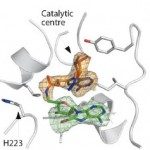Link to Pubmed [PMID] – 17686780
J. Biol. Chem. 2007 Nov;282(47):33925-34
Here we describe the crystal structures of the NAD kinase (LmNADK1) from Listeria monocytogenes in complex with its substrate NAD, its product NADP, or two synthesized NAD mimics. We identified one of the NAD mimics, di-adenosine diphosphate, as a new substrate for LmNADK1, whereas we showed that the closely related compound di-5′-thioadenosine is a novel non-natural inhibitor for this enzyme. These structures suggest a mechanism involving substrate-assisted catalysis. Indeed, sequence/structure comparison and directed mutagenesis have previously shown that NAD kinases (NADKs) and the distantly related 6-phosphofructokinases share the same catalytically important GGDGT motif. However, in this study we have shown that these enzymes use the central aspartate of this motif differently. Although this acidic residue chelates the catalytic Mg(2+) ion in 6-phosphofructokinases, it activates the phospho-acceptor (NAD) in NADKs. Sequence/structure comparisons suggest that the role of this aspartate would be conserved in NADKs and the related sphingosine and diacylglycerol kinases.

